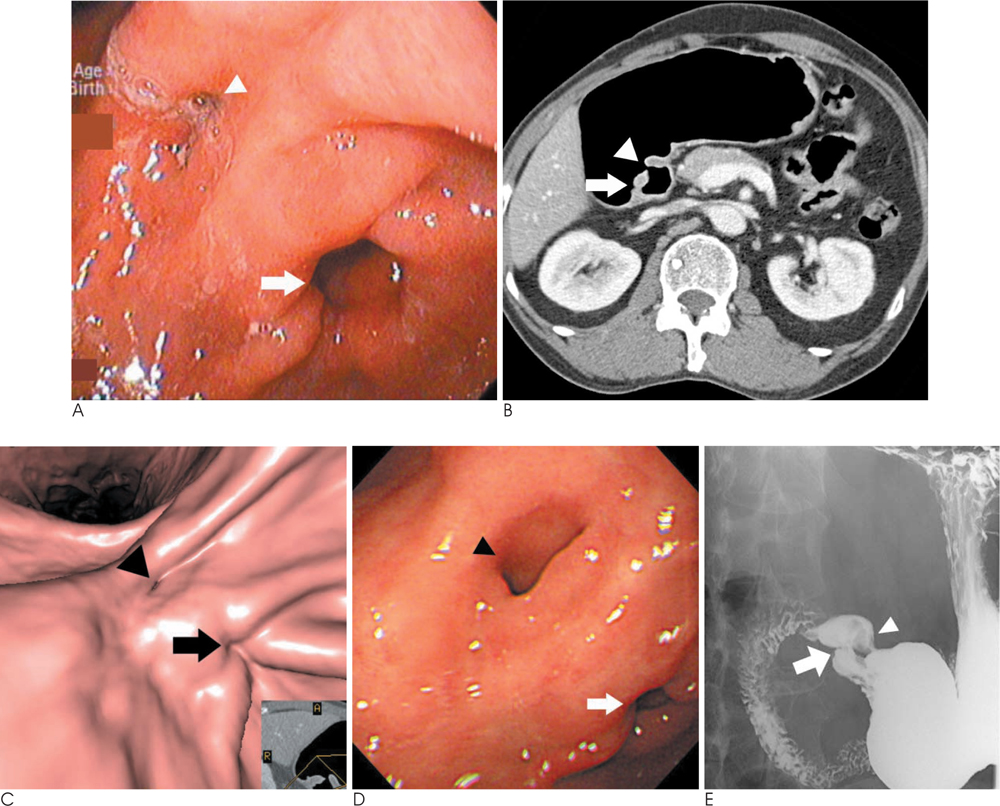J Korean Soc Radiol.
2010 Sep;63(3):245-247. 10.3348/jksr.2010.63.3.245.
Double Pylorus After a Peptic Ulcer in the Gastric Antrum: A Case Report
- Affiliations
-
- 1Department of Diagnostic Radiology, Chonnam National University Medical School, Chonnam National University Hospital, Gwang-Ju, Korea.
- 2Department of Diagnostic Radiology, Chonnam National University Medical School, Chonnam National University Hwasun Hospital, Jeollanam-do, Korea. jw4249@hanmail.net
- 3Department of Hepato-Pancreato-Biliary Surgery, Chonnam National University Medical School, Chonnam National University Hospital, Gwang-Ju, Korea.
- KMID: 2097900
- DOI: http://doi.org/10.3348/jksr.2010.63.3.245
Abstract
- Double pylorus is an accessory channel between the gastric antrum and duodenal bulb with a normal pyloric canal. It is understood that the etiology of double pylorus is a congenital anomaly or an acquired complication after the occurrence of peptic ulcer disease. We report the CT findings with CT gastrography of double pylorus as a complication after a previous peptic ulcer in the gastric antrum.
Figure
Reference
-
1. Kothandaraman KR, Kutty KP, Hawken KA, Barrowman JA. Double pylorus--in evolution. J Clin Gastroenterol. 1983; 5:335–338.2. Jamshidnejad J, Koehler RE, Narayan D. Double channel pylorus. AJR Am J Roentgenol. 1978; 130:1047–1050.3. Kreinsen U, Kammerer W, Dohnert G. A contribution to the knowledge of the so-called pyloric band ( “Double pylorus”). Virchows Arch A Pathol Anat Histol. 1975; 367:163–170.4. Bender MD, Soffa DJ. Acquired double pylorus: a case report. Radiology. 1975; 116:325–326.5. Smith VM, Tuttle KW. Gastroduodenal (pyloric) band. Endoscopic findings and first reported case. Gastroenterology. 1969; 56:331–333.6. Kwan WH, Yeung WH, Chan TM, Cheng CS. Double pylorus with occult gastrointestinal bleeding. J HK Coll Radiol. 2001; 4:157–159.7. Hegedus V, Poulsen PE, Reichardt J. The natural history of the double pylorus. Radiology. 1978; 126:29–34.8. Friehling JS, Rosenthal LE. Gastric carcinoma presenting as double-channel pylorus on upper gastrointestinal series. Dig Dis Sci. 1985; 30:269–273.9. Ghahremani GG, Gore RM, Fields WR. Acquired double pylorus due to gastroduodenal fistula complicating peptic ulceration. Arch Surg. 1980; 115:194–198.10. Thompson WM, Norton G, Kelvin FM, Gedgaudas RK, Halvorsen RA, Rice RP. Unusual manifestations of peptic ulcer disease. Radiographics. 1981; 1:1–16.


